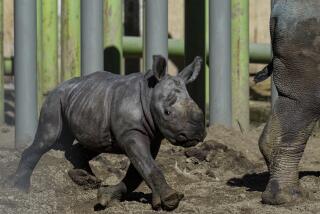Zoo is sending its Sumatran rhino ‘home’
It’s rare for a zoo to get an animal from its native land; most animals on exhibit these days were born in zoos. This weekend, the Los Angeles Zoo takes the even more unusual step of sending an animal to its indigenous land.
The zoo’s male Sumatran rhino, one of the world’s most endangered mammals, will return to his roots. Well, technically, his roots are in Cincinnati: He was born at the zoo there in September 2001. But after three years in Los Angeles, the animal -- named Andalas -- is moving to a rhino sanctuary on the island of Sumatra in Indonesia to be part of a captive breeding program.
“It’s very significant that he’s going back,” said Michael Dee, the zoo’s general curator. “It’s like he’s going full circle.... He will help repopulate the wild.”
There are only about 300 Sumatran rhinos in areas of Indonesia and Malaysia, according to zoo officials, the population decimated over the last two decades by poachers of the animals’ horns, valued in some Asian cultures for purported medicinal benefits. The Indonesian government and zoos around the world are struggling to keep the Sumatran species from becoming extinct. Although the population of Javan rhinos is the tiniest -- 60 to 80 -- they are fairly well protected in a small area of Java, Dee said.
Andalas, whose moniker is the ancient name of Sumatra, is one of four Sumatran rhinos in U.S. zoos, all on loan from the Indonesian government. “The only other Sumatran rhinos in this country are his mother, his father and his sister,” said Jason Jacobs, director of public relations for the L.A. Zoo. They are all at the Cincinnati Zoo.
Andalas’ departure will leave the L.A. Zoo with one Indian rhino, Randa, who at 37 is possibly the oldest Indian rhinoceros in North America.
As is usually the case with national and international transfers of captive animals, there’s a prospective love match on the horizon for Andalas, a hairy, reddish-brown rhino who weighs a relatively sleek 1,540 pounds. Three females at the Sumatran Rhino Sanctuary in the Way Kambas National Park on Sumatra await his arrival.
“The hope is he’ll be able to produce offspring with all three of them,” Dee said. “It would be really nice if it happens with the older female. It’s possible she’s nonreproductive. She’s had some medical problems.”
The Sumatrans are the smallest and hairiest of the five rhino species, all endangered. Their horns are modest, and, contrary to popular images of rhinos, it’s their massive lower incisors that they use for defense.
“Only the African rhinos use the horn as a defense,” Dee said. “I think, for the most part, rhinos have a tendency to be relatively gentle.”
Andalas may enjoy the change of scenery. A month ago, he was seen nervously pacing in his enclosure as nearby construction in the zoo drove noise levels up. Keepers allowed him to take refuge in his quieter off-exhibit barn, and he immediately calmed down, Dee said.
The rhino’s 24-hour-plus journey to the Sumatran sanctuary is expected to begin this morning, when he will be put in a crate, which he is trained to walk into, and fly via KLM airline first to Amsterdam and then to Jakarta. With him will be his keeper, Steve Romo, and the zoo’s chief veterinarian, Dr. Curtis Eng.
Once he lands in Jakarta, Andalas will be driven to the coast and put on a ferry for the 2 1/2 -hour trip to Sumatra. Then he will be trucked another three hours to the sanctuary.
“He’ll be able to lie down in the crate,” Dee said. “He’ll have his keeper with him.”
*
More to Read
Sign up for Essential California
The most important California stories and recommendations in your inbox every morning.
You may occasionally receive promotional content from the Los Angeles Times.











